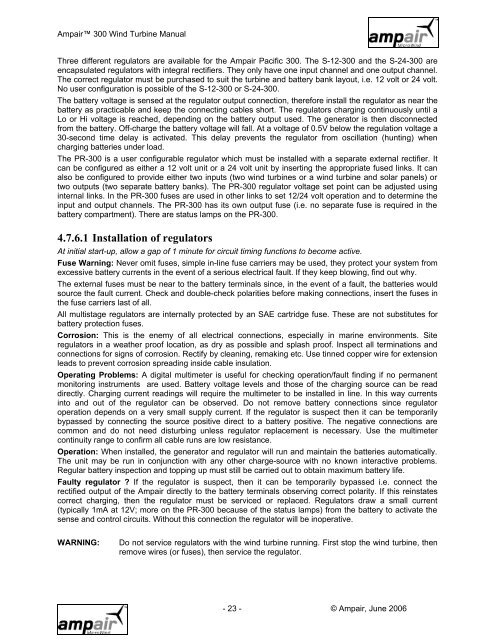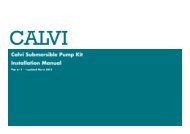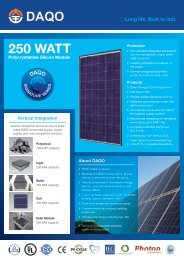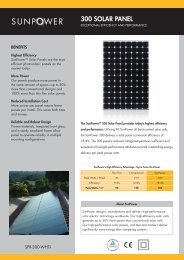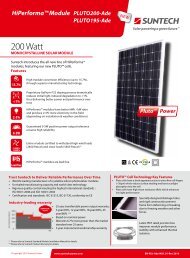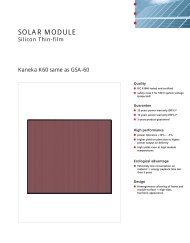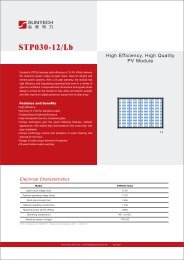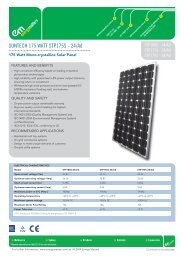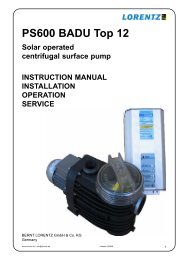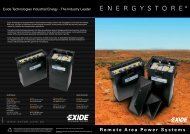Ampair Pacific 300 Wind Turbine Manual - Energy Connect UK
Ampair Pacific 300 Wind Turbine Manual - Energy Connect UK
Ampair Pacific 300 Wind Turbine Manual - Energy Connect UK
Create successful ePaper yourself
Turn your PDF publications into a flip-book with our unique Google optimized e-Paper software.
<strong>Ampair</strong> <strong>300</strong> <strong>Wind</strong> <strong>Turbine</strong> <strong>Manual</strong>Three different regulators are available for the <strong>Ampair</strong> <strong>Pacific</strong> <strong>300</strong>. The S-12-<strong>300</strong> and the S-24-<strong>300</strong> areencapsulated regulators with integral rectifiers. They only have one input channel and one output channel.The correct regulator must be purchased to suit the turbine and battery bank layout, i.e. 12 volt or 24 volt.No user configuration is possible of the S-12-<strong>300</strong> or S-24-<strong>300</strong>.The battery voltage is sensed at the regulator output connection, therefore install the regulator as near thebattery as practicable and keep the connecting cables short. The regulators charging continuously until aLo or Hi voltage is reached, depending on the battery output used. The generator is then disconnectedfrom the battery. Off-charge the battery voltage will fall. At a voltage of 0.5V below the regulation voltage a30-second time delay is activated. This delay prevents the regulator from oscillation (hunting) whencharging batteries under load.The PR-<strong>300</strong> is a user configurable regulator which must be installed with a separate external rectifier. Itcan be configured as either a 12 volt unit or a 24 volt unit by inserting the appropriate fused links. It canalso be configured to provide either two inputs (two wind turbines or a wind turbine and solar panels) ortwo outputs (two separate battery banks). The PR-<strong>300</strong> regulator voltage set point can be adjusted usinginternal links. In the PR-<strong>300</strong> fuses are used in other links to set 12/24 volt operation and to determine theinput and output channels. The PR-<strong>300</strong> has its own output fuse (i.e. no separate fuse is required in thebattery compartment). There are status lamps on the PR-<strong>300</strong>.4.7.6.1 Installation of regulatorsAt initial start-up, allow a gap of 1 minute for circuit timing functions to become active.Fuse Warning: Never omit fuses, simple in-line fuse carriers may be used, they protect your system fromexcessive battery currents in the event of a serious electrical fault. If they keep blowing, find out why.The external fuses must be near to the battery terminals since, in the event of a fault, the batteries wouldsource the fault current. Check and double-check polarities before making connections, insert the fuses inthe fuse carriers last of all.All multistage regulators are internally protected by an SAE cartridge fuse. These are not substitutes forbattery protection fuses.Corrosion: This is the enemy of all electrical connections, especially in marine environments. Siteregulators in a weather proof location, as dry as possible and splash proof. Inspect all terminations andconnections for signs of corrosion. Rectify by cleaning, remaking etc. Use tinned copper wire for extensionleads to prevent corrosion spreading inside cable insulation.Operating Problems: A digital multimeter is useful for checking operation/fault finding if no permanentmonitoring instruments are used. Battery voltage levels and those of the charging source can be readdirectly. Charging current readings will require the multimeter to be installed in line. In this way currentsinto and out of the regulator can be observed. Do not remove battery connections since regulatoroperation depends on a very small supply current. If the regulator is suspect then it can be temporarilybypassed by connecting the source positive direct to a battery positive. The negative connections arecommon and do not need disturbing unless regulator replacement is necessary. Use the multimetercontinuity range to confirm all cable runs are low resistance.Operation: When installed, the generator and regulator will run and maintain the batteries automatically.The unit may be run in conjunction with any other charge-source with no known interactive problems.Regular battery inspection and topping up must still be carried out to obtain maximum battery life.Faulty regulator ? If the regulator is suspect, then it can be temporarily bypassed i.e. connect therectified output of the <strong>Ampair</strong> directly to the battery terminals observing correct polarity. If this reinstatescorrect charging, then the regulator must be serviced or replaced. Regulators draw a small current(typically 1mA at 12V; more on the PR-<strong>300</strong> because of the status lamps) from the battery to activate thesense and control circuits. Without this connection the regulator will be inoperative.WARNING:Do not service regulators with the wind turbine running. First stop the wind turbine, thenremove wires (or fuses), then service the regulator.- 23 - © <strong>Ampair</strong>, June 2006


